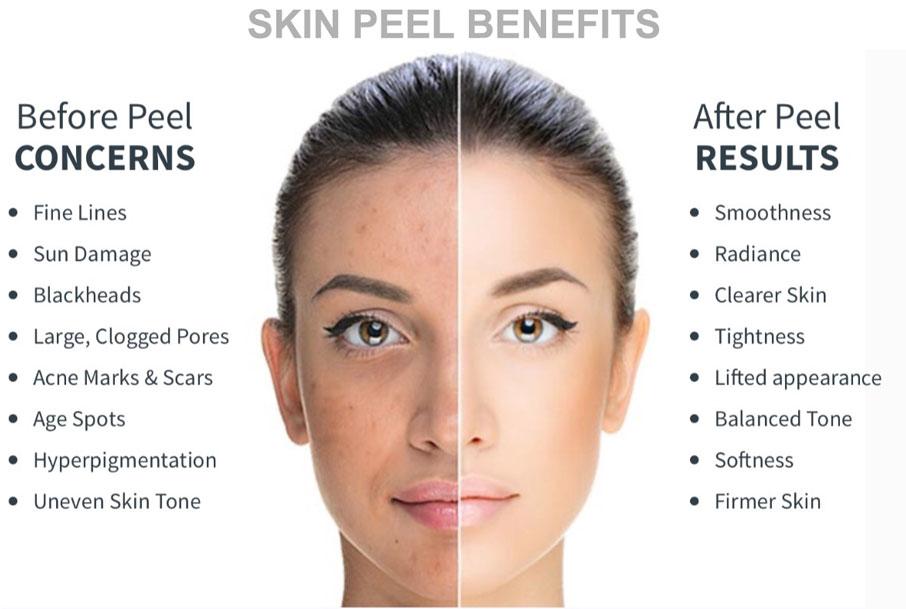Achieving glowing, youthful skin is a common goal for many, and chemical peeling has emerged as a popular and effective treatment to address various skin concerns. Whether you’re dealing with acne scars, fine lines, or uneven skin tone, chemical peels can help rejuvenate your complexion. This blog delves into what chemical peeling is, its benefits, the different types available, and what you can expect from the procedure.
What is Chemical Peeling?
Chemical Peeling on Face involves applying a solution to the skin that causes it to exfoliate and eventually peel off. The new skin that regenerates is usually smoother, less wrinkled, and more even in tone and texture. Chemical peels can be done at different depths (light, medium, or deep) depending on the desired results and the condition of the skin.
Benefits of Chemical Peeling
Chemical peels offer a multitude of benefits, making them a versatile solution for various skin issues:
1. Improves Skin Texture and Tone:
- Chemical peels effectively remove dead skin cells, promoting the growth of new, healthy skin. This results in a smoother and more even skin texture.
2. Reduces Fine Lines and Wrinkles:
- By stimulating collagen production, chemical peels help to reduce the appearance of fine lines and wrinkles, giving the skin a more youthful appearance.
3. Treats Acne and Acne Scars:
- Certain types of chemical peels are excellent for treating acne and reducing acne scars. They help to unclog pores, reduce inflammation, and promote healing.
4. Minimizes Sun Damage:
- Chemical peels can lighten sunspots and hyperpigmentation caused by UV exposure, restoring a more uniform skin tone.
5. Enhances Skincare Products:
- By removing the top layer of dead skin cells, chemical peels enhance the absorption and effectiveness of your skincare products.
Types of Chemical Peels
Chemical peels are categorized based on their depth of penetration into the skin:
1. Superficial Peels:
- Ingredients: Alpha-hydroxy acids (AHAs) like glycolic acid, lactic acid.
- Uses: Mild exfoliation for treating fine lines, acne, and uneven skin tone.
- Downtime: Minimal to none. Some redness and mild peeling may occur.
2. Medium Peels:
- Ingredients: Trichloroacetic acid (TCA), Jessner’s solution.
- Uses: More pronounced results for treating wrinkles, acne scars, and pigmentation.
- Downtime: Moderate. Expect redness, swelling, and peeling for several days.
3. Deep Peels:
- Ingredients: Phenol, high-strength TCA.
- Uses: Treating deep wrinkles, severe sun damage, and deep scars.
- Downtime: Significant. Requires a longer recovery period with more intensive aftercare.
The Procedure
The chemical peeling procedure typically involves the following steps:
- Consultation:
- A thorough consultation with a dermatologist or skincare specialist to determine the most suitable type of peel for your skin type and concerns.
- Preparation:
- The skin is cleansed thoroughly to remove any oils or makeup.
- Application:
- The chemical solution is applied to the face. You may experience a mild tingling or burning sensation, depending on the strength of the peel.
- Neutralization and Removal:
- For some peels, the solution is neutralized after a specific period, while others may self-neutralize.
- Aftercare:
- Post-peel care is crucial to ensure optimal healing and results. This includes avoiding sun exposure, using gentle skincare products, and following the dermatologist’s instructions.
What to Expect After a Chemical Peel
The recovery and results vary based on the depth of the peel:
- Superficial Peels: Minimal downtime, with mild redness and peeling. Skin usually heals within a week.
- Medium Peels: Redness, swelling, and more noticeable peeling. Healing can take up to two weeks.
- Deep Peels: Significant redness, swelling, and peeling. Complete recovery may take several weeks to months.
Potential Side Effects
While chemical peels are generally safe, some potential side effects include:
- Redness and irritation
- Peeling and crusting
- Changes in skin color (hyperpigmentation or hypopigmentation)
- Scarring (rare)
Conclusion
Chemical peels are a powerful tool in the quest for radiant, youthful skin. With their ability to address a variety of skin concerns, from fine lines to acne scars, they offer a customizable solution for individuals seeking noticeable improvements in their complexion. By consulting with a qualified dermatologist and following appropriate aftercare, you can achieve beautiful, rejuvenated skin through chemical peeling. If you’re considering this treatment, schedule a consultation to explore the best options tailored to your skin’s needs and goals.

